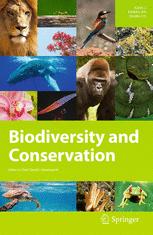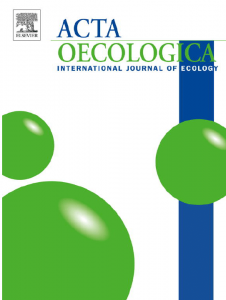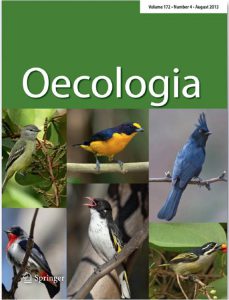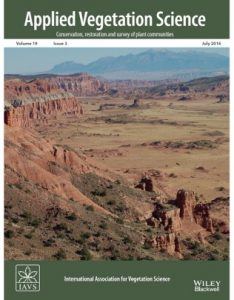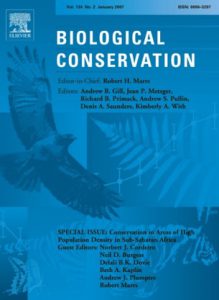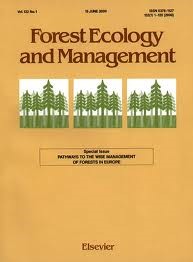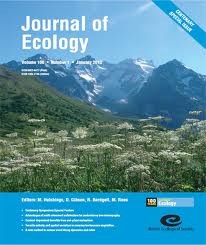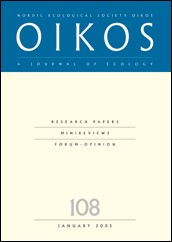Publications. Peer-reviewed articles
- García-Hernández MA, López-Barrera F, Pérez-Ramos I, Sosa V, Perea R. 2025. Acorn dispersal effectiveness after 27 years of passive and active restoration in a Neotropical cloud forest. Science of the Total Environment 966, 178770. PDF
- Gordaliza G, Miranda García-Rovés JC, López R, Aranda I, Gil L, Perea R, Rodríguez-Calcerrada J. 2025. Herbivory legacy modifies leaf economic spectrum and drought tolerance in two tree species. Oecologia 2017(2), 1-15. PDF
- Carvalho J, Carpio A, Fonseca C, Ferreira E, Serrano E, Barja I, Sánchez-Zapata JA, Carranza J, Barbero-Palacios L, Ortiz-Jiménez L, Rosalino LM, Rossa M, Velamazán M, Santos N, Fandos P, Acevedo P, Perea R, Castillo-Contreras R, Pascual-Rico R, Jiménez-Ruiz S, Tinoco R. 2025. Three decades of research on Iberian wild ungulates: key insights and promising research avenues. Mammal Review e12384, PDF
- Peláez M, López-Sánchez A, Rodríguez-Calcerrada J, Dirzo R, Perea R. 2024. Trade-offs between herbivory and drought in tree seedlings of contrasting oak species. Annals of Botany mcae178. PDF.
- Peláez M, Carranza G, Gambra D, Rodríguez-Calcerrada J, González-Gordaliza G, Fedriani J.M. Gil, L, Perea R. 2024. Acorn removal and seedling age determine oak (Quercus ilex and Q. suberL.) restoration outcome in ungulate-dominated Mediterranean environments. Annals of Forest Science 81: 38. PDF
- Montero-Botey M, Kivuyo E, Sitati N, Perea R. 2024. Deforestation and water availability as main drivers of human-elephant conflict. Global Ecology and Conservation 54, e03068. PDF
- García del Barrio JM, Perea R, Villafuerte-Jordán R, Martínez-Jáuregui M. 2024. Early detection of wild ungulates herbivory cessation in Mediterranean landscapes using Hill numbers as vascular plant diversity indices. Land 13. PDF
- Capó M, Rodríguez-Calcerrada J, Peláez M, Carranza G, Gambra D, Perea R. 2024. Shrub interaction with oak seedlings under high herbivory pressure: the role of ontogeny, drought, and plant competition. Forest Ecology and Management https://doi.org/10.1016/j.foreco.2024.121797
- Fernandes GW, Ramos L, Santos JC, Perea R, Moreira R, Cuevas-Reyes P, Dirzo R. 2024. Vulnerability of seedlings to herbivores and pathogens attack: the importance of plant vigor and plant nutritional quality in Hymenaea courbaril. Arthropod-Plant Interactions. https://link.springer.com/article/10.1007/s11829-024-10067-4
- Rubio-Cuadrado A, Alberdi I, Cañellas I, Montes F, Rodríguez-Calcerrada J, López R, Gordaliza G, Valbuena-Carabaña M, Nanos N, Perea R, Gil L. 2024.Twenty years of population dynamics in a southernmost beech-oak forest anticipate changes in its structure and composition. Forest Ecosystems 11, 100197.
- López-Sánchez A, Sánchez I, Herráez F, Gülçin D, Tang T, Perea R, Velazquez J. 2023. Identifying keystone connectivity spots under climate change: application to conservation and management of riparian systems. Journal of Environmental Management 351, 119782 https://doi.org/10.1016/j.jenvman.2023.119782
- Montero-Botey M, Perea R. 2023. Infrared barriers as a tool to reduce Human-Elephant Conflicts. Wildlife Biology. https://doi.org/10.1002/wlb3.01124
- García-Hernández MA, López-Barrera F, Perea R. 2023. Simulated partial predation on the largest-seeded oak: effects of seed morphology and size on early establishment. Forest Ecology and Management 534: 120863. https://doi.org/10.1016/j.foreco.2023.120863
- Luelmo-Lautenschlaeger R, Morales-Molino C, Blarquez O, Pérez-Díaz S, Sabariego-Ruiz S, Ochando J, Carrión JS, Perea R, Fernández-González F, López-Sáez JA. 2023. Long-term vegetation history of a relict birch forest (Betula pubescens subsp. celtiberica (Rothm. & Vasc.) Rivas Mart.) in the Toledo Mountains (central Iberia). Conservation implications. Review of Palaeobotany and Palynology. https://www.sciencedirect.com/science/article/pii/S0034666723000751
- Montero-Botey M, Perea R. An increasing human‑elephant conflict? Impact of African elephant on cultivated cashew trees. European Journal of Wildlife Research 69:5. https://doi.org/10.1007/s10344-022-01629-z
- Siqueira WK, Moura AL, Perea R, Alves M, Fernandes GW. 2022. The role of Baccharis shrubs in the short-term restoration of Atlantic Rainforest. Nature Conservation Research 7(2): 42–53.
- Perea R., Schroeder J.W., Dirzo R. 2022. The herbaceous understory plant community in the context of the overstory: An overlooked component of tropical diversity. Diversity 14, 800. PDF
- López-Sánchez A, Capó M, Rodríguez-Calcerrada J, Peláez M, Solla A, Martín JA, Perea R. 2022. Exploring the use of solid biofertilisers to mitigate the effects of Phytophthora oak root disease. Forests 13, 1558. PDF
- Martínez-Torres, H., López-Olvera, J. R., Mentaberre, G., Cardells-Peris, J., Lizana, V., Tampach, S., & Torres-Blas, I. INCREMENTO C, Serrano E. (2022). A homemade stretcher for ungulate transport. Galemys, 34, 40-43. PDF
- Montero-Botey M, Soliño M, Perea R, Martínez-Jaúregui M. 2022. Let’s give voice to local farmers: Preferences for farm-based strategies to enhance human-elephant coexistence in Africa. Animals 12(14): 1867. PDF
- Refoyo, P, Peláez, M, García-Rodríguez, M., López-Sánchez, A. & Perea, R. 2022. Moss cover and browsing scores as ecological indicators of unsustainable mountain ungulate populations in Mediterranean environments. Biodiversity and Conservation. https://doi.org/10.1007/s10531-022-02454-1
- Peláez M, San Miguel A, Rodríguez-Vigal C, Moreno-Gómez A, García del Rincón A, Perea, R. 2021. Using retrospective life-tables to predict the effect of climate change on ungulates demography. Ecology and Evolution. https://onlinelibrary.wiley.com/doi/full/10.1002/ece3.8218
- García-Rodríguez M, Aroztegui J, López-Sánchez A, Peláez M, Perea R. 2021. A pressure indicator of Iberian wild goat impact on moss and soils in Mediterranean climate. Euro-Mediterranean Journal for Environmental Integration 6, 76. https://link.springer.com/article/10.1007/s41207-021-00283-2
- López-Sánchez A, Roig S, Dirzo R, Perea R. 2021. Effects of domestic and wild ungulate management on young oak size and architecture. Sustainability, 13, 7930. PDF
- Rubio-Cuadrado A, Camarero JJ, Rodríguez-Calcerrada J, Perea R, Gómez C, Montes F, Gil L. 2021. Impact of successive spring frosts on leaf phenology and radial growth in three deciduous tree species with contrasting climate requirements in central Spain. Tree Physiology. Accepted. PDF
- Montero-Botey M, Soliño M, Perea R, Martínez-Jáuregui M. 2021. Exploring rangers´ preferences for community-based strategies to increase human-elephant coexistence in African natural corridors. Animal Conservation. https://doi.org/10.1111/acv.12700. PDF
- Peláez M, Sanuy I, Peral JC, Álvarez-Esteban JL, Lavín S, Serrano E, Perea R. 2021. Early life investment in antlers and body growth reflects adult performance in roe deer population under supplementary feeding conditions. Integrative Zoology. doi: 10.1111/1749-4877.12535. PDF
- Siqueira WK, Perea R, Pereira MJ, Lamounier A, Fernandes GW. 2021. The role of Baccharis shrubs in the short-term restoration of Atlantic Rainforest. Ecologia Austral.
- Perea R, Dirzo R, Bieler S, Fernandes GW. 2021. Incidence of galls on sympatric California oaks: Ecological and physiological perspectives. Diversity 13, 20. https://doi.org/10.3390/d13010020
- López-Sánchez A, Perea R. 2020. The use of biological liquid fertilizers against oak decline associated with Phytophthora. New Forests (early view). https://doi.org/10.1007/s11056-020-09818-x
- Rubio-Cuadrado A, Gómez C, Rodríguez-Calcerrada J, Perea R, Gordaliza G, Camarero JJ, Montes F, Gil L. 2020. Differential response of oak and beech to late frost damage: an integrated analysis from organ to forest. Agricultural and Forest Meteorology. 108243. https://doi.org/10.1016/j.agrformet.2020.108243
- López-Sánchez A, Johnson I, Dirzo R, Perea R. 2020. Matching species traits and microsites improves regeneration in mixed oak woodlands. Applied Vegetation Science. PDF
- Perea R, López-Sánchez A, Pallarés J, Gordaliza G, González-Doncel I, Gil L, Rodríguez-Calcerrada J. 2020. Tree recruitment in a drought- and herbivory-stressed oak-beech forest: implications for future species coexistence. Forest Ecology and Management 477: 118489. PDF
- Velamazán M, Perea R, Bugalho M. 2020. Ungulates and ecosystem services in Mediterranean woody systems: A semi-quantitative review. Journal for Nature Conservation 55: 125837 https://doi.org/10.1016/j.jnc.2020.125837
- López-Sánchez A, Perea R, Roig S, Isselstein J, Schmitz A. 2020. Challenges on the conservation of traditional orchards: Tree damage as an indicator of sustainable grazing. Journal of Environmental Management 257: 110010. PDF
- Alonso-Martínez L, Ibañez M, Brolly M, Burnside N, Calleja JA, Peláez M, López-Sánchez A Bartolomé J, Fanlo E, Lavín S, Perea R, Serrano E. 2020. Remote mapping of foodscapes using sUAS and a low cost BG2 NIR sensor. Science of the Total Environment 718: 137357. PDF
- Montero-Botey M, San Miguel A, Perea R. 2020. Food preferences determine human-elephant coexistence in African woodlands. Oryx (early view). https://doi.org/10.1017/S0030605319000978
- Morales-Molino C, Tinner W, Perea R, Carrión JS, Colombaroli D, Valbuena-Carabaña M, Zafra E, Gil L. 2019. Unprecedented herbivory threatens rear-edge populations of Betula in southwestern Eurasia. Ecology 100(11), e02833. https://doi.org/10.1002/ecy.2833
- Perea R, Cunha JS, Spadeto C, Gomes VM, Moura AL, Rúbia B, Fernandes GW. 2019. Nurse shrubs to mitigate plant invasion along roads of montane Neotropics. Ecological Engineering 136: 193-196. PDF
- Perea R., Fernandes GW, Dirzo, R. 2019. Early plant development depends on embryo damage location: the role of seed size in insect seed predation. Oikos (early view) 1111/oik.06912 PDF
- López-Sánchez A, Peláez M, Dirzo R, Fernandes GW, Seminatore M, Perea R. 2019. Spatio-temporal variation of biotic and abiotic stress agents determines seedling survival in assisted oak regeneration. Journal of Applied Ecology 56: 2663-2674. PDF
- Perea R, Cunha JS, Spadeto C, Gomes VM, Moura AL, Rúbia B, Fernandes GW. 2019. Nurse shrubs to mitigate plant invasion along roads of montane Neotropics. Ecological Engineering 136: 193-196. PDF
- López-Sánchez A, Perea R, Roig S. 2019. Are large-nested bird colonies compatible with the conservation of grazed woodlands? Global Ecology and Conservation 20: e00705. PDF
- Schroeder J, Martin J, Angulo D, Arias-Del Razo Itzel, Barbosa J, Perea R, Sebastián-González E, Dirzo R. 2019. Host plant phylogeny and abundance predict root-associated fungal community composition and diversity of mutualists and pathogens. Journal of Ecology. DOI: 10.1111/1365-2745.13166. PDF
- Peláez M, Dirzo R, Fernandes GW, Perea R. 2019. Nurse plant size and biotic stress determine quantity and quality of plant facilitation in oak savannas. Forest Ecology and Management 437: 435-442. PDF
- Velamazán M, San Miguel A, Escribano R, Perea R. 2018. Use of firebreaks and artificial supply points by wild ungulates: Effects on fuel load and woody vegetation along a distance gradient. Forest Ecology and Management 427: 114-123. PDF
- Peláez, M., Perea R, Díaz, M, San Miguel, A., Rodríguez-Vigal, C., Côté, S. 2018. The use of cast antlers to assess antler size variation in red deer populations: Effects of mast seeding, climate and population features in Mediterranean environments. Journal of Zoology 306: 8-15. PDF
- Morales-Molino C., Colombaroli D., Tinner W., Perea R, Valbuena-Carabaña M, Carrión J.S., Gil L. 2018. Vegetation and fire dynamics during the last 4000 years in the Cabañeros National Park (central Spain). Review of Palaeobotany and Palynology 253: 110-122. PDF
- Velamazán, M., San Miguel, A., Escribano, R., Perea, R. 2018. Compatibility of regeneration silviculture and wild ungulates in a Mediterranean pine forest: Implications for tree recruitment and woody plant diversity. Annals of Forest Science 75: 35. PDF
- Schroeder, J.W., Martin J.T., Barbosa, J., Perea, R., Arias I., Sebastián-González E., Dirzo, R. 2018. Community composition and diversity of Neotropical root-associated fungi in common and rare trees. Biotropica 50: 694-703
- Perea, R., Fernandes, G.W., Dirzo, R. 2018. Embryo size as a tolerance trait against seed predation: Contribution of embryo-damaged seeds to plant regeneration. Perspectives in Plant Ecology, Evolution and Systematics 31: 7-16. PDF
- García-Cervigón, A.I., Żywiec M, Delibes M, Suárez-Esteban A., Perea R, Fedriani J.M. 2018. Microsites of seed arrival: spatio-temporal variations in complex seed-disperser networks. Oikos (early view). Doi: 10.1111/oik.04881. PDF
- Charro, J.L., López-Sánchez, A., Perea R. 2018. Traditional cattle vs. introduced deer management in Chaco Serrano woodlands (Argentina): Analysis of environmental sustainability at increasing densities. Journal of Environmental Management 206: 642-649. PDF
- Dittel, J., Perea, R., Vander Wall, S. 2017. Reciprocal pilfering in a seed-caching rodent community: implications for species coexistence. Behavioral Ecology and Sociobiology 71: 147. PDF
- Perea, R., López-Sánchez A., Dirzo, R. 2017. Differential tree recruitment in Californian oak savannas: Are evergreen oaks replacing deciduous oaks? Forest Ecology and Management 399: 1-8. PDF
- Velamazán, M., San Miguel, A., Escribano, R., Perea, R. 2017. Threatened woody flora as an ecological indicator of large herbivore introductions. Biodiversity and Conservation 26: 917-930. PDF
- Peláez, M., San Miguel, A., Rodríguez-Vigal, C., Perea, R. 2017. Climate, female traits and population features as drivers of breeding timing in Mediterranean red deer populations. Integrative Zoology 12: 396-408. PDF
- Perea, R, López-Sánchez, A., Roig, S. 2016. The use of shrub cover to preserve Mediterranean oak dehesas: a comparison between sheep, cattle and wild ungulate management. Applied Vegetation Science 19: 244-256. PDF
- Perea, R, Dirzo, R, San Miguel, A. & Gil, L. 2016. Post-dispersal seed recovery after dispersal. Is it a plant or an animal-driven process? Oikos 125: 1203-1210. PDF
- Charco, J, Perea, R., Gil, L., Nanos, N. 2016. Impact of deer rubbing on pine forests: Implications for conservation and management of Pinus pinaster populations. European Journal of Forest Research 135: 719-729. PDF
- Fernández-Olalla, M, Martínez-Jauregui, M, Perea R, Velamazán, M & San Miguel, A. 2016. Threat or opportunity? Effects of an alien ungulate on the highly diverse vegetation of southeastern Spain. Journal of Arid Environments 129: 9-15
- López-Sánchez, A., Perea, R., Dirzo, R., Roig, S. 2016. Livestock vs. wild ungulate management in the conservation of Mediterranean dehesas: Implications for oak regeneration. Forest Ecology and Management 362: 99-106
- Perea, R, Gutiérrez-Galán, A. 2016. Introducing cultivated trees into the wild: Wood pigeons as dispersers of domestic olive seeds. Acta Oecologica 71: 73-79. PDF
- Perea, R., Perea-Garcia-Calvo, R., Diaz-Ambrona, C. & San Miguel, A. 2015. The reintroduction of a flagship ungulate Capra pyrenaica: Assessing sustainability by surveying woody vegetation. Biological Conservation 181: 9-17. DOI: 10.1016/j.biocon.2014.10.018. PDF
- Perea, R., Girardello, M. & San Miguel, A. 2014. Big game or big loss? High deer populations are threatening woody plant diversity and vegetation dynamics. Biodiversity and Conservation 23: 1303-1318. DOI: 10.1007/s10531-014-0666-x. PDF
- Perea, R. & Gil, L. 2014. Shrubs facilitating seedling performance in ungulate-dominated systems: biotic versus abiotic mechanisms of plant facilitation. European Journal of Forest Research 133:525-534. doi: 10.1007/s10342-014-0782-x. PDF
- Perea, R. & Gil, L. 2014. Tree regeneration under high levels of wild ungulates: The use of chemically vs. physically-defended shrubs. Forest Ecology and Management 312:47-54 doi: 10.1016/j.foreco.2013.10.022. PDF
- Perea, R., Venturas, M. & Gil, L. 2014. Seed predation on the ground or in the tree? Size-related differences in behavior and ecology of granivorous birds. Acta Ornithologica 49: 119–130. DOI 10.3161/000164514X682940. PDF
- Venturas M, Fuentes-Utrilla P, López R, Perea R, Fernández V, , Gascó A, Guzmán P, Meng L, Rodríguez-Calcerrada J, Miranda E, Domínguez J, González G, Zafra E, Fajardo-Alcántara M, Martín JA, Ennos R, Nanos N, Lucena JJ, Iglesias S, Collada C & Gil L. 2014 Ulmus laevis Pallas a native elm in the Iberian Peninsula: a multidisciplinary approach. iForest-Biogeosciences and Forestry doi: 10.3832/ifor1201-008. PDF
- Perea, R., Venturas, M. & Gil, L. 2013. Empty seeds are not always bad: Simultaneous effect of seed emptiness and masting on animal seed predation. Plos One 8(6): e65573. doi:10.1371/journal.pone.0065573. PDF
- Perea, R., Delibes, M., Polo, M., Suárez-Esteban, A. & Fedriani, J.M. 2013. Context-dependent fruit-frugivore interactions: partner identities and spatio-temporal variation. Oikos 122: 943-951. PDF
- Millerón, M., López-Heredia, U., Lorenzo, Z., Perea, R., Dounavi, A., Alonso, J., Gil, L. & Nanos, N. 2012. Effect of canopy closure on pollen dispersal in a wind pollinated species (Fagus sylvatica L.). Plant Ecology 213: 1715-1728. PDF
- Vander Wall, S.B., Enders, M., Barga, S., Moore, C.M., Seaman, A. & Perea, R. 2012. Jeffrey pine seed dispersal in the Sierra San Pedro Mártir, Baja California, Mexico. Western North American Naturalist 72(4):534-542
- Perea, R., López, D., San Miguel, A & Gil, L. 2012. Incorporating insect infestation into rodent seed dispersal: Better if the larva is still inside. Oecologia. 170(3): 723-733. PDF
- Perea, R., San Miguel, A., Martínez-Jáuregui, M., Valbuena-Carabaña, M. & Gil, L. 2012. Effects of seed quality and seed location on the removal of acorns and beechnuts. European Journal of Forest Research 131, 623-631. DOI: 10.1007/s10342-011-0536-y. PDF
- Bullock, J.M., White S.M., Prudhomme, C., Tansey C., Perea R. & Hooftman, D.A.P. 2012. Modelling spread of British wind dispersed plants under future wind speeds in a changing climate. Journal of Ecology 100, 104-115. PDF
- Perea, R., González, R., San Miguel, A. & Gil, L. 2011. Moonlight and shelter cause differential seed removal and selection by rodents. Animal Behaviour 84, 717-723. PDF
- Perea, R., San Miguel, A. & Gil, L. 2011. Flying vs. climbing: factors controlling arboreal seed removal in oak-beech forests. Forest Ecology and Management. 262: 1251-1257. PDF
- Perea, R., San Miguel, A. & Gil, L. 2011. Leftovers in seed dispersal: ecological implications of partial seed consumption for oak regeneration. Journal of Ecology 99, 194-201. PDF
- Perea, R., San Miguel, A. & Gil, L. 2011. Acorn dispersal by rodents: the importance of re-dispersal and distance to shelter. Basic and Applied Ecology 12, 432-439. PDF
- Perea, R., San Miguel, A. & Gil, L. 2011. Disentangling the factors controlling fruit and seed removal by rodents in temperate forests. Seed Science Research 21, 227-234. PDF
- San Miguel, A., Perea, R. & Fernández, M. 2010. Wild ungulates vs. Extensive livestock. Looking Back to Face the Future. Options méditerranéennes, 92:27-34. PDF

